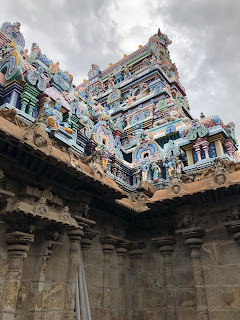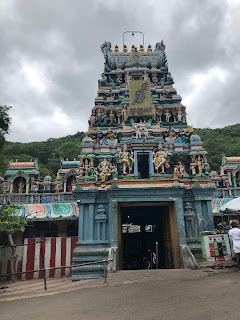You may have noticed that we have featured a few temples in and around the city of Madurai in the posts so far. Madurai is an ancient city located in the southern part of Tami lNadu, India and is an ideal city in many ways to explore the lesser known temples of Tamil Nadu and other interesting sites in southern Tamil Nadu. We based ourselves in Madurai last summer for a couple of weeks to explore the deep south.
This is an ancient city with a lot of history. Capital city of the ancient Pandian Kingdom, it was a major metropolis even in the time of the Roman Empire in Europe. Madurai might be much older. There are many legends about the origins of the city which are obscure. Legends abound. Many ancient records within India and beyond mention the the city of Madurai. One of the oldest periods is referred to as the Sangam period when the Pandian kings of Madurai are believed to have presided over a collegium of poets who created a body of literature, some which are still in existence. Legend tells us that there were three Sangams and that the present Madurai, on the banks of the river Vaigai is the location of the last Sangam, while the previous two further south were inundated by the sea. Recent excavations at Keeladi, a few kilometres downstream on the banks of the Vaigai, are uncovering evidence of an ancient, advanced settlement possibly contemporaneous to the Harappan or Indus Valley Civilization.
Many dynasties have ruled this city and have left their mark. In Sangam times, the Pandian kings ruled this city and the surrounding country which was known as Pandya Nadu. Pandya Nadu together with Chola Nadu (the area around The Kaveri delta) and Chera Nadu (present day Kerala) were the three main Kingdoms of the Sangam period. There were many other minor kingdoms. The Pandian kings have ruled on and off until the14th century in Madurai with many intervening periods when other dynasties ruled here. Sometimes after the Sangam period, in the first half of the first millennium CE, a dynasty called the Kalabhra are supposed to have ruled Madurai. The details of these kings are obscure and some even question whether such a dynasty ever existed. In the 6th century, Pandyan rule was revived and continued until the mid 10th century when the expanding Chola empire subsumed it for a few centuries. During those 2-3 centuries Madurai was a provincial capital of the Chola empire. By the early 13th century, Pandyan power was again revived for a short period when the Chola empire crumbled and the Pandians emerged as the major power in the Tamil country and beyond. This was cut short in the early 14th century when civil war broke out with two half brothers competing for the throne at Madurai which led to intervention from the Delhi Sultanate. The subsequent raid by Malik Kafur, the general of the army of the Delhi Sultanate was known for it wanton destruction of Madurai. After many such raids by the forces of Delhi, Madurai became a Muslim Sultanate for about 60 years. In the late 1300s the expanding Hindu empire of Vijayanagar wrested control of Madurai from the Sultanate of M'bar. In the late 1500s when Vijayanagar lost power, their provincial governors called Nayakkar became independent kings and Madurai was ruled by the Madurai Nayakkar dynasty until the 18th century. There onwards it was briefly under the control of the Nawab of Arcot before passing in to hands of the colonial British, first as an outpost of the British East India Company and later in the 19th century as a provincial city in the Madras Presidency of the British Raj in India. In independent India it is a Tier 2 city in the state of Tamil Nadu.
The religious and cultural beliefs of the Sangam era are little known. Some of it is evident from the literature of that period. Some archeological evidence is emerging recently. The religious beliefs appear to have been more local in origin and not very formal. In the post Sangam period, Buddhism and Jainism, two great religions originating in the Gangetic Plain in around present-day Bihar, held sway in the Tamil country for several centuries. Many of the kings belonged to these two faiths. While Jainism persisted until about the 12th century, with many ancient sites related to this religion around Madurai, Buddhism disappeared early and left very few physical traces. From the 6th century onwards, the two Hindu traditions of Saivism and Vaishnavism based on Vedic Hindu principles, went through a revival in the Tamil country and became the dominant religious traditions. The worship of Murugan, a deity who is often revered as the Tamil god and likely predated the advent Vedic Hinduism in the Tamil county, is also widely celebrated and many temples have been dedicated to lord Murugan.
Today Madurai is a chaotic and densely populated metropolis with all the problems facing contemporary Indian cities. But things are changing with better sanitation (poor sanitation was a legacy of the British Raj which neglected such issues), accomodation and transportation facilities.
Madurai has many interesting sights for the visitor and beautiful temples for the pilgrim. It is best known for the Meenakshi Sundareswarar Temple better known as the Madurai Meenakshi Temple. In many ways it is the centre of this ancient city around which it revolves. The remnants of the Nayakkar Place or Mahal is also another interesting historical site. In this blog we will concentrate on lesser known temples and sites.
How to get there? Madurai is easily reached by domestic flights from many major Indian cities including the state capital of Chennai. The airport is modern and comfortable. There are modern four-laned highways that lead to it from all directions. It is about an 8 hour drive from Chennai. It is smooth driving for the most part. It is also well-connected by rail, although we are not fans of rail travel in India in general.
Where do you stay? Our recommendations are based on comfort, safety, reputation and cleanliness. We generally stay at upscale hotels. In Madurai there are many nice hotels including budget ones. Please do your own research
1. The Gateway Pasumalai - Owned and operated by the legendary Taj group this is a 5 star hotel perched on the top a hill with panoramic views of the city below. Home to a large flock of resident peacocks. We have stayed many times and will recommend it anyway. Wonderful place to stay.
2. The Heritage Madurai - 5 star hotel in the heart of the city. We have not stayed but have had lunch here. Excellent choice. Designed by the legendary Sri Lankan architect Geoffrey Bawa to reflect traditional Tamil architecture.
3. Regency Madurai by GRT Hotels - 3 star hotel. We have not stayed or visited but have stayed at many GRT hotels which have been excellent.
4. Courtyard by Marriott Madurai - 3 star hotel. We have not stayed. It is highly rated and belongs to the Marriott chain and should be fine.
 |
| Madurai Meenakshi Amman |
 |
| Vandiyur Mariamman Theppakulam |
 |
| Madurai Meenakshi Amman |
 |
| View of Madurai from Pasumalai |


































